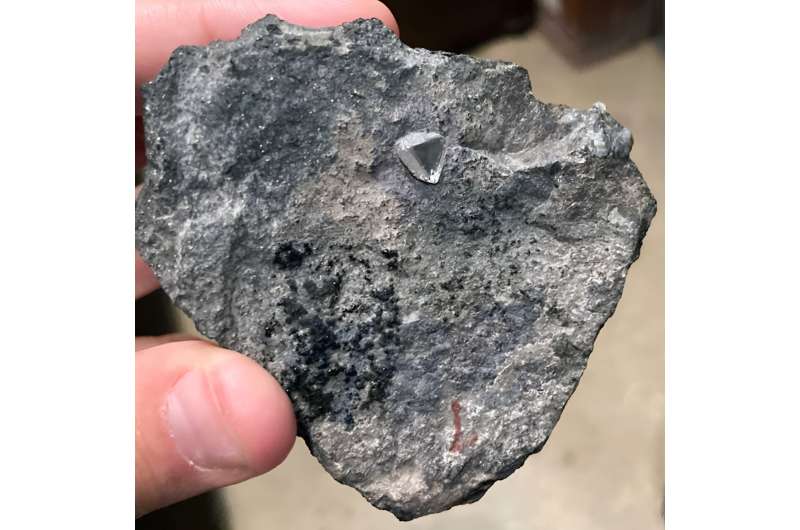In a fascinating development within the world of gemstone hunting, geologists from ETH Zurich and the University of Melbourne have made a significant discovery. Their work focuses on the tricky search for diamonds – rare jewels that can only be located where bluish-black kimberlite rock is present, typically on ancient continental blocks. These experts have established an intriguing link between the iron-to-magnesium ratio in olivine (a mineral) and diamond content in kimberlite, a correlation potentially paving the way for simpler diamond detection. According to the study, olivine-rich iron is generally diamond-free, while olivine abundant in magnesium tends to contain more diamonds. This remarkable insight has compelled scientists to investigate the chemical composition of kimberlites further, particularly observing the metasomatism process inside the Earth, which ultimately creates diverse mineral forms due to hot liquids and melts interacting with rocks. Crucially, the olivine’s magnesium content — and therefore the diamond preservation — hinges on the degree of lithospheric mantle penetration by the metasomatism process. Adopted by De Beers, a leading diamond producer and trader, this innovative method for examining olivine has proved simpler than previous diamond-hunting approaches.

1. The Relationship between Diamonds and Olivine
Understanding the mineral link
Diamonds, those captivating gems, are not as easy to find or recognize as you might think. Their occurrence is deeply tied to the presence and composition of specific minerals, primarily olivine. Scientists, particularly from ETH Zurich and the University of Melbourne, have managed to trace a link between diamonds and olivine, unveiling a fascinating connection that may simplify the daunting task of precious gem prospecting.
Overview of olivine’s role in diamond formation
Olivine plays a significant role in the formation of diamonds thanks to its particular chemical composition and the environment in which it thrives. As a key mineral in kimberlite, the primary volcanic rock known for carrying diamonds to the Earth’s surface, olivine aids in the processes involved in diamond formation and survival.
Implications of olivine’s chemical composition on diamond occurrence
What makes olivine so relevant to diamonds is its chemical makeup – specifically, its iron and magnesium content. The ratio of these two elements in olivine directly influences the occurrence of diamonds, and monitoring this ratio can hint at areas more likely to produce these sought-after gems.
2. The Genetic Problems of Diamond Detection
The existence of diamonds in kimberlite rock
The elusive nature of diamonds is partly due to their specific location, typically confined within kimberlite rocks. These bluish-black rocks are the main conduit for diamonds to reach the Earth’s surface. Just finding kimberlite rock, however, isn’t a guarantee of finding diamonds.
Specific geographical locations of kimberlite rock
Kimberlite rock is concentrated in very old continental blocks, where geological activity over millions of years has brought them to the surface. These rock formations are not found everywhere but are more prevalent in regions like South Africa, Canada, Australia, and Russia.
Influence of the age of continental blocks on diamond presence
The age of the continental blocks where kimberlite rock is found significantly influences diamond occurrence. The areas with the oldest continental blocks, undisturbed by recent geological activity, tend to have a higher presence of diamonds, as these precious gems have had enough time to form.
3. The Iron-to-Magnesium Ratio in Olivine and its Connection to Diamond Content
Discovery and explanation of the link
Discovering the connection between the iron-to-magnesium ratio in olivine and diamond content is considered a breakthrough in gem prospecting. Researchers found that this ratio could predict whether a kimberlite rock is diamondiferous, simplifying the previously complicated detection process.
Effects of different levels of iron and magnesium in olivine on diamond content
The iron and magnesium levels in olivine directly affect the diamond content in kimberlite. Essentially, the higher the iron level, the lower the diamond content, and vice versa – more magnesium leads to more diamonds.
Possibility of improving diamond detection through observations of olivine’s chemical composition
Analyzing olivine’s chemical composition can lead to more efficient diamond detection. By examining the iron-to-magnesium ratio in olivine, geologists can make more accurate predictions about diamond presence in certain areas, thereby optimizing exploration efforts.
4. The Effects of Olivine High in Iron on Diamond Content
Low diamond presence in olivine-rich in iron
Olivine high in iron unfortunately doesn’t bode well for diamond occurrence. Typically, areas where olivine is iron-rich result in few or even no diamonds in the corresponding kimberlite rock. Understanding this unfortunate correlation is crucial when deciding where to invest exploration resources.
Reasons behind the scarcity of diamonds in iron-rich olivine
Iron-rich olivine creates an environment less suitable for diamond formation. This skew in the iron-to-magnesium ratio is commonly associated with areas of heavier geological activity where the conditions necessary for diamond creation are disturbed.
Role of iron in the formation and destruction of diamonds
While iron plays a pivotal role in many geological processes, it seems to be detrimental to diamond formation and preservation. An iron-rich composition tends to correlate with unstable conditions for diamond preservation and may cause destruction of these precious gems.

5. The link between High Magnesium Content in Olivine and Diamond Emergence
Observation of more diamonds in magnesium-rich olivine
On the other side of the spectrum, olivine high in magnesium is more promising for diamond prospectors. Magnesium-rich olivine is often associated with a high diamond content in the enclosing kimberlite rock, providing an encouraging beacon in the challenging endeavor of diamond detection.
Reasons for the abundance of diamonds in olivine with high magnesium content
The abundance of diamonds in areas with magnesium-rich olivine is due to the favorable conditions such minerals create for diamond formation and growth. With a high level of magnesium, the environment is more stable and less prone to the destructive processes that can sabotage diamond development.
Importance of magnesium in diamond preservation
Magnesium in olivine appears to play a crucial role in diamond preservation. More specifically, in areas of low geological activity, the magnesium-rich environment can stabilize the conditions, increasing the likelihood for diamonds to form and survive.
6. Process of Diamond Summation Using the Chemical Composition of Kimberlites
Using the metasomatism process for diamond detection
A recent breakthrough in diamond detection lies in examining the metasomatism process in the Earth’s interior. This process involves hot liquids and melts reacting with rock to form different minerals. Analyzing these minerals can provide hints towards the presence or absence of diamonds.
Differentiation of minerals for easier identification of diamonds
Differentiation of minerals aids in easier identification of diamonds. Certain minerals indicate favorable conditions for the formation of diamonds, and their presence or absence offers clues to gem hunters.
Effects of hot liquids and melts reacting with rock in the metasomatism process
The reaction of hot liquids and melts with rock changes the makeup of the Earth’s interior and affects the chances of diamond formation. This, in turn, impacts the ratio of iron to magnesium in olivine and consequently influences the number of diamonds in a given area.

7. Detrimental Effects of Metasomatism Process on Diamonds
Role of transitional melts in Destroying diamonds
Transitional melts, involved in the metasomatism process, can penetrate the lithospheric mantle and prove detrimental for diamonds. They alter the composition of the rocks, leading to an increase in the iron content in olivine, which is unfavorable for diamond preservation.
Changes in rock composition due to metasomatism process
As the metasomatism process changes the composition of rocks, it also reduces the chances of diamond survival. The changes typically involve an increase in iron content and a decrease in magnesium, resulting in unfavorable conditions for diamonds.
Resulting increase in iron content in olivine
Increased iron content in olivine isn’t good news for diamonds. Iron-rich olivine typically means fewer diamonds due to the destructive processes accompanied by such a change.
8. Preservation of Diamonds through Less Metasomatism Effect on Olivine
Mitigation of the penetration from melts into the lithospheric mantle
Less penetration from melts into the lithospheric mantle leads to less metasomatism. This lower level of metasomatism allows for more stable conditions conducive to the formation and preservation of diamonds.
Effects of low metasomatism levels on diamond preservation
Low levels of metasomatism lead to higher magnesium contents in olivine, promoting an environment favorable for diamond formation and survival. The reduction of metasomatic effects, therefore, is a crucial aspect of diamond prospecting.
The high magnesium level contribution to diamond stability
High magnesium levels in olivine contribute to diamond stability. This underscores the importance of maintaining such conditions when engaging in diamond exploration and extraction.

9. Introduction of a New Method for Analyzing Olivine
Simplification process of the new diamond detection method
A simplified method for analyzing olivine has been recently introduced, aiming to ease the complex process of diamond detection. This technique specifically targets olivine’s chemical composition, monitoring the iron-to-magnesium ratio to forecast diamond occurrence.
Comparison of the new method with previous diamond detection techniques
The new method represents a significant improvement from previous diamond detection techniques. It bases predictions on solid ground— the chemical composition of olivine— instead of using less accurate and more complex procedures.
Early implementations of new methods in the gem industry
This new technique has been quickly adopted in the gem industry. Major diamond producers, like De Beers, have started using this approach to improve the efficiency of their searches and the accuracy of their results.
10. The Impact of New Olivine Analysis on the Diamond Industry
Adoption of the olivine analysis method by De Beers and other diamond producers
The adoption of the new olivine analysis method by industry juggernauts, like De Beers, reflects its efficiency and potential. It has allowed these companies to optimize their exploration efforts and increase their yield of diamonds.
Improved efficiency and accuracy in diamond detection
The use of the new olivine analysis method has resulted in significant improvements in both the efficiency and accuracy of diamond detection in the industry. It provides clear guidance for prospectors, reducing the time and cost associated with unsuccessful searches.
The potential influence of this technique on future diamond explorations and trading
Looking forward, the impact of the new olivine analysis method is expected to be profound on the entire diamond industry. From exploration to trading, this technique promises to revolutionize the way we detect and value diamonds. Its influence should not be underestimated, as it marks a turning point in our journey to understanding and appreciating these beautiful gemstones.

